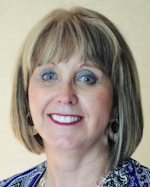We owe the code D4346 to eight hygienists who came together to create a code that was missing from the CDT Code. At the time, there were two prophylaxis codes (D1110 and D1120) in the preventive category. Therapeutic procedures such as scaling and root planing (D4341/D4342) were in the periodontics category. There were no procedure codes for therapeutic treatment for patients with gingival disease with no attachment/recession/bone loss.
The California Dental Hygienists’ Association created a task force on debridement in 2013. Their assignment was to develop a relevant definition for D4355, full mouth debridement. They also considered a new gingivitis-type procedure code to fill the gap.
The submission to the coding commission
Nomenclature: Scaling performed in the presence of moderate to severe gingival inflammation.
Descriptor: Scaling performed in the presence of moderate to severe gingival inflammation with no clinical attachment loss (recession, bone loss).
Rationale: Dentists and dental hygienists promote regular dental visits to evaluate the current dental status of patients and recommend preventive, therapeutic, and/or restorative treatment. When it comes to preventive and therapeutic procedures related to periodontal structures, selection of an appropriate procedure code that reflects the appropriate treatment is limited.
You might also want to read
The dental codes you need to know
The steps toward a code
The first step was to complete a code action request form for the code maintenance committee. One of the questions was: Does the request represent the official position of a dental organization or a recognized dental specialty, a third-party payer or administrator, or the manufacturers/suppliers of the product?
The second step was to describe the rationale behind the request. This included the reasons why the existing procedure code was inadequate, a description of technology inherent to the procedure, and dental schools where it’s taught.
The group decided to expand on the rationale and add, “Once preventive/periodontal treatment has been determined, selection of a procedure code must be either preventive (adult prophylaxis) or periodontal (full-mouth debridement, scaling and root planning, or periodontal maintenance if history of SRP). There is currently no procedure code for a patient who presents with significant gingival inflammation and significant amounts of calculus and plaque but exhibits no clinical attachment loss, which includes recession and bone loss.
The third step was to provide additional supporting documentation. This included references to articles, research, etc. The group filled out the necessary paperwork for the revised D4355 as well as the new code they thought should be D1130 and submitted them. Then they waited to hear if it was accepted to be presented at the April 10, 2015, code maintenance committee meeting. These were the first two code submissions ever made by a group of hygienists.
Since no one in the group had ever attended the CMC, they didn’t realize it would have been beneficial to have someone there to represent them and provide testimony and answer questions. Many of the voting CMC members had questions.
Since the submission dealt with a specific issue, the CMC members decided to table it and refer it to a CMC ad-hoc working group for review and a recommendation for action during the 2016 CMC meeting. This was another first for hygienists.
What came next to create a code
The CMC working group met the next year and submitted the following for CDT 2017:
Nomenclature: D4346—Scaling in presence of generalized moderate or severe gingival inflammation, full mouth, after oral evaluation. This language is almost identical to what the CDHA task force submitted.
Descriptor: The removal of plaque, calculus, and stains from supra- and subgingival tooth surfaces when there is generalized moderate or severe gingival inflammation in the absence of periodontitis. It is indicated for patients who have swollen, inflamed gingiva, generalized suprabony pockets, and moderate to severe bleeding on probing. This should not be reported in conjunction with prophylaxis, scaling and root planing, or debridement procedures.
Rationale: There is a CDT code gap. Current codes document treatment procedures for patients with a healthy periodontium, or patients with periodontal disease who have accompanying loss of attachment such as periodontal pockets and bone loss. D1110 is a preventive procedure applicable for patients with healthy periodontium. Codes D4341 and D4342 are therapeutic and indicated for patients who require both scaling and root planing due to loss of attachment. However, there is no CDT code available to report therapeutic treatment of patients with gingival disease and no attachment loss.
This passed unanimously! The American Dental Association finally realized it was time to recognize the procedure and create a new code. The language for this new code was largely influenced by the CDHA task force.
The CDHA should be commended for addressing this important aspect of dental hygiene services—language that adequately and accurately describes the services hygienists provide to patients. Never before had dental hygienists had a direct impact on the development of a procedure included in the CDT manual.
Since 2016, the DentalCodeology Consortium has been working with hygienists to create new or revised submissions to present each year at the CMC meeting. At least one of the DCC directors attends to answer questions. Although not all their submissions have been adopted, they appreciate the presence of dental hygienists.
Anyone can suggest a new procedure code or an amendment to an existing code. The ADA has guidelines posted on their website. One of the goals of the DentalCodeology Consortium is “develop and submit dental procedure code proposals (submissions) to the American Dental Association’s code maintenance committee at their yearly meeting in March.” Hygienists CAN make a difference!
Editor's note: This article appeared in the January-February 2024 print edition of RDH magazine. Dental hygienists in North America are eligible for a complimentary print subscription. Sign up here.
Kathy S. Forbes, BS, RDH, has been a dental hygienist, educator, speaker, author, consultant, seminar, and study club leader for more than 40 years. She holds a license with the ADA for Current Dental Terminology, which allows her to provide the most up-to-date understanding of current procedure codes. Kathy currently serves as a director for the Dental Codeology Consortium, reviewing and developing procedure codes relevant to dental hygiene practice that are presented to the Code Maintenance Committee of the American Dental Association in March each year.
Connie Simmons, MA, BSDH, RDH, earned her BSDH from The Ohio State University and her MA in aging studies from Wichita State University. She’s worked in clinical hygiene for almost 35 years and has other roles in clinical training, sales, speaking, and writing. Her knowledge of dental insurance and coding grew while working with an insurance carrier, and she’s now part of the Dental Codeology Consortium and an associate productivity coach with Inspired Hygiene. She’s also an expert in the clinical use of silver diamine fluoride. Reach her at [email protected].








